The Ten Worst Microsoft Product Names of All Time
By Harry McCracken | Wednesday, April 1, 2009 at 11:31 pm
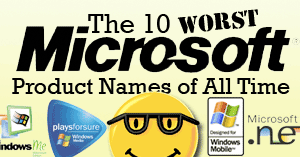 [NOTE: I wrote this piece for my pals at PC World, who kindly agreed to let me publish it here, too.]
[NOTE: I wrote this piece for my pals at PC World, who kindly agreed to let me publish it here, too.]
If Microsoft had invented the iPod, it would have been called the Microsoft I-pod Pro 2005 Human Ear Professional Edition. The cult-hit video that makes that assertion may have been a joke, but it rings true. And when word emerged that the video was a self-parody produced within Microsoft, the point was even clearer: The world’s largest software developer just isn’t very good at naming stuff.
Some Microsoft names sound clunky; some are confusing; some are undignified or overambitious. More than any other company in technology, the behemoth of Redmond loves to change product names–often replacing one lackluster label with an equally uninspired one. Microsoft has also been known to mess up some names that are actually perfectly good, such as Windows and Word, by needlessly tampering with them.
Herewith, in chronological order, are ten Microsoft names that could have been a lot better, together with some semiconstructive advice on monikers that would have more euphonious and/or more accurate. I also selected six not-quite-as-bad runners-up.
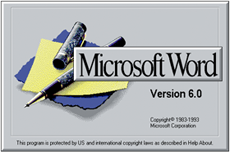 1993: Word 6.0 for Windows: When Microsoft upgraded 1991’s popular Word 2.0 for Windows, it replaced it with…no, not something logical like Word 3.0. Rather, it blithely hopscotched over three version numbers and landed at Word 6.0. The official explanation for the skippage was that it brought the Windows edition’s version number into line with that of the older DOS incarnation of Word. But conspiracy theorists noted that it also allowed Word to catch up with archrival WordPerfect, which also released a version 6.0 in 1993.
1993: Word 6.0 for Windows: When Microsoft upgraded 1991’s popular Word 2.0 for Windows, it replaced it with…no, not something logical like Word 3.0. Rather, it blithely hopscotched over three version numbers and landed at Word 6.0. The official explanation for the skippage was that it brought the Windows edition’s version number into line with that of the older DOS incarnation of Word. But conspiracy theorists noted that it also allowed Word to catch up with archrival WordPerfect, which also released a version 6.0 in 1993.
Whatever the rationale, the move rendered the practical purpose of version numbers meaningless, thereby setting a bad example for other companies such as Netscape, which later went straight from Netscape Navigator 4.0 to version 6.0.
What it should have been called: Word 3.0 for Windows. Simple and accurate.
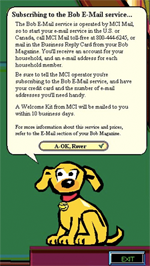 1995: Microsoft Bob. When I asked my Twitter and Facebook pals to nominate bad Microsoft names, this legendarily lousy Windows front-end hosted by animated characters came up far more often than any other product. It’s possible that the badness of the product has tarnished its title. But as several people pointed out, “Microsoft Bob” is both cutesy-cute and uninformative–it doesn’t give you an inkling as to what the product is all about. (The box featured a smiley face wearing Bill Gates-like nerdy glasses, but the main character in the interface was a dog named Rover, who was later revived for Windows XP’s misbegotten search feature.)
1995: Microsoft Bob. When I asked my Twitter and Facebook pals to nominate bad Microsoft names, this legendarily lousy Windows front-end hosted by animated characters came up far more often than any other product. It’s possible that the badness of the product has tarnished its title. But as several people pointed out, “Microsoft Bob” is both cutesy-cute and uninformative–it doesn’t give you an inkling as to what the product is all about. (The box featured a smiley face wearing Bill Gates-like nerdy glasses, but the main character in the interface was a dog named Rover, who was later revived for Windows XP’s misbegotten search feature.)
What it should have been called: Well, Microsoft Rover would have been at least slightly more descriptive–especially since the product itself was such a dog.
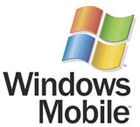 1996-present: Every name ever associated with handheld devices running Microsoft software. At first, they were called Handheld PCs, and ran an OS known as Windows CE. Then they morphed into Palm PCs–until the PalmPilot people complained, whereupon they became Palm-Size PCs. But only briefly: Soon, Microsoft wanted us to call them Pocket PCs, and the software they ran was renamed Windows Mobile.
1996-present: Every name ever associated with handheld devices running Microsoft software. At first, they were called Handheld PCs, and ran an OS known as Windows CE. Then they morphed into Palm PCs–until the PalmPilot people complained, whereupon they became Palm-Size PCs. But only briefly: Soon, Microsoft wanted us to call them Pocket PCs, and the software they ran was renamed Windows Mobile.
That name stuck around when the OS migrated from PDAs to phones, although it bifurcated into two editions: Windows Mobile Pocket PC and Windows Mobile Smartphone. Then Microsoft declared that there were three Windows Mobile variants–Windows Mobile Classic, Windows Mobile Professional, and Windows Mobile Standard. As for the devices themselves, Steve Ballmer declared in February of this year that they’d be known henceforth as Windows Phones–scratch the “Mobile.” Except for the fact that the OS is still Windows Mobile. Got that?What they should have been called: Melvin. Or just about anything else, really, as long as it didn’t keep changing.
 2000: .NET. In the mid-1990s, critics accused Microsoft was accused by many of being slow to jump on the Internet bandwagon. By the dawn of the new millennium, however, it was firmly on board–and in June 2000, it unveiled a vision for online services it called .NET. As originally articulated, .NET addressed consumers, businesses, and developers, and it involved everything from programming languages to an online version of Microsoft Office to calendaring and communications services to a small-business portal to stuff for PDAs, cell phones, and gaming consoles. It was so wildly ambitious, so all-encompassing, and so buzzword-laden that it pretty much defied comprehension, at least if you weren’t a professional geek. Which the company seemed to realize–it quickly stopped pushing the concept to consumers, instead restricting it to programming tools.
2000: .NET. In the mid-1990s, critics accused Microsoft was accused by many of being slow to jump on the Internet bandwagon. By the dawn of the new millennium, however, it was firmly on board–and in June 2000, it unveiled a vision for online services it called .NET. As originally articulated, .NET addressed consumers, businesses, and developers, and it involved everything from programming languages to an online version of Microsoft Office to calendaring and communications services to a small-business portal to stuff for PDAs, cell phones, and gaming consoles. It was so wildly ambitious, so all-encompassing, and so buzzword-laden that it pretty much defied comprehension, at least if you weren’t a professional geek. Which the company seemed to realize–it quickly stopped pushing the concept to consumers, instead restricting it to programming tools.
What it should have been called: How about “Virtually Everything Microsoft Does Involving the Internet From This Day Forward,” or VEMDIFTDF for short? Or what if Microsoft had simply declared that it was now Web-centric, period–no new branding required?
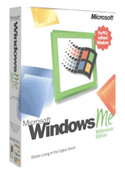 2000: Windows Millennium Edition. Microsoft couldn’t call this successor to Windows 98 “Windows 2000” because it had already assigned that name to Windows NT’s replacement. So the company saddled the OS with a name that was both pretentious and goofy, and gave it the overly adorable (and badly capitalized) nickname “Windows Me.” It was probably bad juju: The product itself went on to be widely reviled as slow, glitchy, and insubstantial; and to this day its name rivals that of Microsoft Bob as shorthand for “crummy software.”
2000: Windows Millennium Edition. Microsoft couldn’t call this successor to Windows 98 “Windows 2000” because it had already assigned that name to Windows NT’s replacement. So the company saddled the OS with a name that was both pretentious and goofy, and gave it the overly adorable (and badly capitalized) nickname “Windows Me.” It was probably bad juju: The product itself went on to be widely reviled as slow, glitchy, and insubstantial; and to this day its name rivals that of Microsoft Bob as shorthand for “crummy software.”
What it should have been called: Windows 2001, especially if Microsoft marketing had assembled an ad campaign involving HAL 9000 and/or apes hurling things at an obelisk. Bonus virtue: That name would have given Microsoft an excuse to delay the OS for six months to fix bugs.
1 2 NEXT PAGE»
15 Comments
Read more:
11 Comments For This Post
4 Trackbacks For This Post
-
[TechBlogWatch] Best of Blogs für den 2.4.2009 | TechFieber | Hot Gadget Blog. Smart Tech News. Says:
April 2nd, 2009 at 3:02 am[…] The Ten Worst Microsoft Product Names of All Time […]
-
Microsoft Laptop Hunters | Armanen Online Says:
April 7th, 2009 at 12:20 pm[…] making sure quickly reject Mac and name drop a couple bigger PC manufacturers. You would think by this time, Microsoft would have fired the second graders running their ad department (or, at the least, those […]
-
Microsoft’s Search Engine Way Behind Google? Must be the Name! | Technologizer Says:
April 8th, 2009 at 9:42 am[…] has a long history of changing the names of underperforming products (and sometimes of products that are doing just fine). I can’t remember an instance of the change being a clear improvement, and changing the […]
-
Games for Windows Gets On Demand Downloads, But Why? | Technologizer Says:
December 3rd, 2009 at 7:29 pm[…] people from thinking of Windows Live, which is something entirely different. Chalk it up to bad naming habits, […]













April 2nd, 2009 at 2:42 am
“which later went straight from Netscape Navigator 4.0 to version 6.0” There was actually a reason for the jump from 4.0 to 5.0. Netscape 5.0 was under development but later got scrapped even though they were well on the way through the project. They then created what became the Gecko rendering engine to replace the existing one. So 5.0 was scrapped and they proceeded with 6.0.
April 2nd, 2009 at 7:18 am
Slightly OT because it’s not a product name, but I’ve always been frustrated by the default “C:Program Files” instead of just “C:Programs”. There is NO REASON for that random space in the middle of the file path.
Same with “C:Documents and Settings” – two directories (“C:Documents” and “C:Settings”) would have made much more logical sense, and eliminated the spaces.
April 2nd, 2009 at 7:29 am
What about Windows 7? Given that it is, in fact, really Windows 6.1…
April 2nd, 2009 at 11:19 am
omg, bob! i remember this silly guy way too well …..
April 2nd, 2009 at 11:51 am
ha! chkdsk brings back memories…
more on-topic: ‘System restore’, the first thing to turn off after installing windows, when in fact it was a ‘System backup’, restore being only the eventual reverse process.
April 2nd, 2009 at 12:12 pm
How about the “Taskbar Notification Area” AKA the System Tray. Even Microsoft calls it the system tray, so why it it’s official name the taskbar notification area?
April 2nd, 2009 at 12:34 pm
I agree with Simon. Windows 7 qualifies for this list too if Word 6 was placed on it for version number manipulation. Windows 7 sounds like a nice, clean name, but its a stretch to call it the 7th version of Windows.
How is it the 7th version? Does it go Windows version 1-2-3-95-2000-Vista-7? Obviously a few products get skipped regardless of how you count it.
April 8th, 2009 at 10:37 pm
Windows 7 comes from the build number of the Windows NT family.
Windows NT 3.x = Windows NT 3.x
Windows NT 4 = Windows NT 4
Windows 2000 = Windows NT 5
Windows XP = Windows NT 5.1
Windows Server 2003 = Windows NT 5.2
Windows Vista = Windows NT 6
Windows Server 2008 = Windows NT 6
Windows 7 = Windows NT 7
So, Windows 2000, Windows XP, and Windows Server 2003 are all considered minor updates from each other, but Vista & 7 are major upgrades? Silly, I know, but that is where it comes from.
August 7th, 2009 at 9:34 am
Windows CE + Windows ME + Windows NT = Windows CEMENT
I think that pretty much sums them up: mixed up, hardened and set in their concrete ways. And just like poorly laid concrete, Microshaft (or at least, Windoze) needs to be broken up.
March 12th, 2010 at 8:44 am
Pre-Windows, MS-Dos 6 was the best OS I ever messed with. When Windows 2.0 finally entered, had it installed for about 4 hours, and got rid of it. Next best bet was 3.1 for Workgroups, pretty good!! NT4 was good also, but with alot of competition from IBM’s OS/2. Though I heard nothing but complaints about Windows 95 and 98, I liked ’em… even ME (people wouldn’t believe me). The most solid citizen was 2000. . BOB, (what the heck was that) then I jumped to XP Pro… then jumped right over Vista (what a complete waste) to now Windows 7. So, that’s my history (big deal, right). I think they need to watch, very closely, LINUX (which I’m sure they are).
December 16th, 2010 at 5:24 am
Microsoft Works